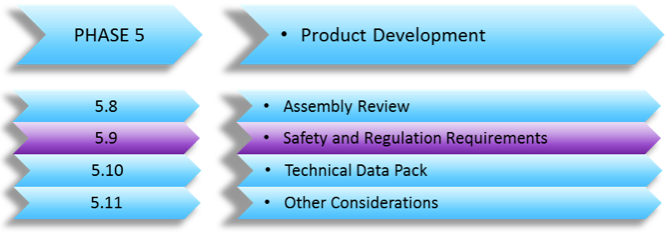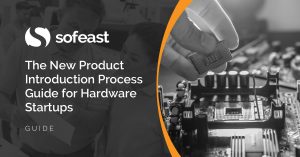 Many companies develop a new product but totally overlook the safety and regulatory requirements that will apply to that new product. We have pulled some information from different sources to give you an idea of what to look out for here in phase 5.9.
Many companies develop a new product but totally overlook the safety and regulatory requirements that will apply to that new product. We have pulled some information from different sources to give you an idea of what to look out for here in phase 5.9.
(Take a look at the whole series on developing a new product here.)
Different countries have different regulations that must be met in order to sell a product within that country. Some other countries stipulate that getting your products certified is voluntary. Sometimes the rules and regulations on what you should ideally do and what you absolutely must do are very confusing. With this in mind, the following information is a guideline only and should not be taken as hard and fast rules.
I am not a qualified legal advisor, therefore I strongly suggest that you contact your local legal advisor and discuss with them what certification if any you need to get your product tested to.
To help you understand what the different marks that are applied to products after testing are, a list is shown below. (source: National Instruments.)
Please remember, this is just a guide to allow you to understand what the different symbols and logo mean and we recommend you contact your independent testing laboratory or local authority to understand what you would need to do in your local area.
Combined UL Mark for Europe, Canada and the United States
Products in compliance with UL’s Listing and Follow-Up Service for Canada and the United States as well as UL’s EU Mark service and factory inspection requirements for Europe are eligible to bear the combined UL Mark for Europe, Canada and the United States. This mark is a step toward addressing customer desire for a single certification mark for multiple key markets. The mark builds on UL’s combined UL certification Marks for Canada and the United States and is the first transcontinental mark in the UL portfolio.
The combined UL Mark for Europe, Canada and the United States generally includes the following:
- UL in a circle symbol with “C,” “US” and “EU” identifiers
- Word “Listed”
- Alphanumeric control number
- Manufacturer’s name or trademark
- Model number
- Product category name (product identifier) as indicated in the appropriate UL directory and UL-EU Mark certificate
When applicable, a combined UL Mark for Europe, Canada and the United States may only be applied as long as a product remains in compliance with all certification programs represented by the combined UL Mark.
Products found to be noncompliant with the terms, conditions or other UL requirements of any of the certification programs for Europe, Canada or the United States are not eligible to bear the combined UL Mark. However, these products can continue to bear individual UL Marks for specific certification programs as long as a product continues to comply with UL’s requirements.
FCC
The Federal Communications Commission (FCC) is an independent United States government agency. The FCC was established by the Communications Act of 1934 and is charged with regulating interstate and international communications by radio, television, wire, satellite and cable. The FCC’s jurisdiction covers the 50 states, the District of Columbia, and U.S. possessions.
All commercial electronic devices (unintentional radio-frequency radiators) sold in the United Sates are regulated by the Federal Communications Commission (FCC) if they are:
- Employ clocks or oscillators
- Operate at a frequency of greater than 9kHz, and
- Use digital technologies
This includes almost every product that contains a microprocessor. If an unintentional radiator is not controlled through proper design using grounding and shielding, the result may be high levels of energy radiated or conducted from the equipment, causing unwanted effects on another device. Specific requirements have been set up by the FCC under Rules and Regulations, Title 47, Part 15 Subpart B. The FCC has broken down Part 15 into two categories, Class A and Class B.
Class A Device: A device marketed for use in an industrial or business environment and not intended for use in the home or residential area.
Class B Device: A device marketed for use in the home or a residential area. Examples of such devices include, but are not limited to, personal computers, calculators, printers, modems, many electronic games, and similar devices that are marketed to the general public.
It is ILLEGAL to sell or even advertise Class A or Class B products until their radiation and conducted emissions have been measured and proven to be in compliance with FCC regulations.
See the top ten reasons products fail testing here.
CE
The CE-marking is the manufacturer’s statement to the EU authorities that his product complies with all relevant CE-marking Directives. It is important to emphasise that the CE-marking is not a quality mark or a guarantee to consumers in the EU.
The manufacturer is always responsible — within or outside EU — for CE-marking. If the manufacturer is not located in the EU, he can authorise a representative located in the EU who thus becomes responsible for CE-marking. The representative’s duties and responsibilities must be agreed in writing.
Importers not authorised by the manufacturer must keep his documentation in safekeeping in EU for ten years after the last production date. Bear in mind that the importer may always be held responsible for the documentation.
CE — The European Conformity (CE) — marking is affixed to products with input of 50 – 1,000 V AC or 75 – 1,500 V DC and/or for products which may cause or be affected by electromagnetic disturbance.
The CE marking symbolizes conformity of the product with the applicable Community requirements. CE is the manufacturer or suppliers’ self-declaration allowing products to circulate freely within the Community. NI products meet the essential requirements of Directives 2004/108/EC (EMC) and 2006/95/EC (product safety), and comply with the relevant standards. Standards for Measurement, Control and Laboratory Equipment include EN 61326 and EN 55011 for EMC, and EN 61010-1 for product safety.
Interested in this topic? You may also like Sofeast’s New Product Launch Roadmap [XLS + Video]
Our ‘new product launch roadmap’ unveils the steps that your supplier will never tell you are needed, and yet all veteran buyers consider as indispensable. Hit the button to get your copy:
C Tick – Australian EMC Compliance Declaration
To limit potential problems of electromagnetic interference (EMI), the Australian Communications Authority (ACA) introduced an EMC protection framework requiring EMC compliance for electronic products.
The C-Tick Mark along with the supplier’s registration number indicates that the product complies with Australian EMI standard AUS/NZ CISPR 11 and establishes a traceable link between the product and the manufacturer.
WEEE – Waste Electrical and Electronic Equipment Directives
In 2003, the European Parliament passed the Waste Electrical and Electronic Equipment (WEEE) directives to encourage the reuse, recycling, and recovery of WEEE and to improve the environmental performance of all operators involved in the life cycle of electrical and electronic equipment, especially those dealing with WEEE.
Member states were required to adopt legislation by August 13, 2005. The regulations apply to all electrical and electronic equipment on the European Union market in that falls into any of 10 categories.
Additional information regarding what is required for RoHS – Restriction of the Use of Certain Hazardous Substances
For reference, there is no longer a separate RoHS mark — it’s now part of the EN directives that requires CE marking.
The RoHS directive aims to restrict certain dangerous substances commonly used in electronic and electronic equipment. Any RoHS compliant component is tested for the presence of Lead (Pb), Cadmium (Cd), Mercury (Hg), Hexavalent chromium (Hex-Cr), Polybrominated biphenyls (PBB), and Polybrominated diphenyl ethers (PBDE).
For Cadmium and Hexavalent chromium, there must be less than 0.01% of the substance by weight at raw homogeneous materials level. For Lead, PBB, and PBDE, there must be no more than 0.1% of the material, when calculated by weight at raw homogeneous materials. Any RoHS compliant component must have 100 ppm or less of mercury and the mercury must not have been intentionally added to the component.
In the EU, some military and medical equipment are exempt from RoHS compliance.
Go to part 15: Technical Data Files for China Production
Disclaimer
We are not lawyers. What we wrote above is based only on our understanding of the regulatory requirements. QualityInspection.org does not present this information as a basis for you to make decisions, and we do not accept any liability if you do so.
Want to learn more about the new product introduction process for hardware startups?
Whether you’re some way along the process, or just starting out, Sofeast’s guide covers everything hardware startups need to know for making a new product in China and successfully bringing it to market.
Hit the button below to read the guide:





